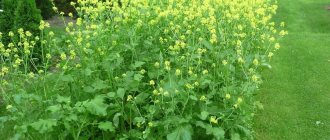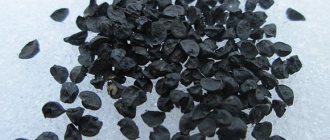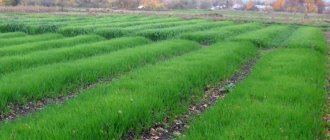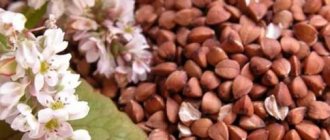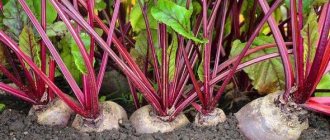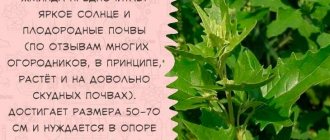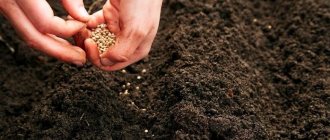Category: Siderata Reading time: 7 min · Views: 4,454
Green manure is used to improve the structure of the soil, protect the site from weeds and the scorching sun, and also replenish the fertile layer of soil with nutrients. When you need to sow oats as green manure, how will it help in the garden? Let us consider in detail the methods of using this crop on a personal plot.
Oats as a crop
Oats are a representative of cereals, which belongs to the early crops and grows everywhere in temperate climates in the form of a loose bush that has leafy stems up to 120 cm high. In nature, annual types of crops are more common, but there are also perennials, although they have not received widespread.
Oats are grown both as a grain and as a green manure. It is not afraid of low temperatures above zero, which allows it to be sown in early spring, when the soil reaches physiological ripeness. However, unlike rye, oats do not tolerate frost.
The plant is quite moisture-loving, especially during seed germination, which is different from barley. Thus, in dry weather conditions, seedlings become sparse, and the plant does not produce a dense vegetative mass.
Oats are also a heat-loving crop, but are unpretentious to the type of soil - they grow on loam, chernozem, peat bogs, clay and sandy soils. Of course, when growing a plant on more fertile soils, the tillering and stem ratio is higher.
The optimal conditions for oats are cool, damp weather, so it is not advisable to use them as green manure in the summer or winter. The ideal time for it is spring and early autumn.
Reviews
- Anastasia, 37 years old: “I use oats as green manure together with rye and wheat. Thanks to them, I have completely fertilized and fertile soil in my garden. I grow absolutely everything on it: potatoes, tomatoes, cucumbers, cabbage. Oats will also allow me to grow large and juicy raspberries, although before this they bore very poorly. The berries were small and literally crumbled in our hands.”
- Sergey, 57 years old: “Oats are a truly unique crop. In the spring I completely plant it on my site. Thanks to this fertilizer, I was able to get rid of the weeds that had previously grown abundantly in the garden. I cannot help but note the quality of the harvest. After adding nutrients, I was finally able to harvest a full onion harvest. And before that, my wife grew onions exclusively for greens, since they didn’t go into heads.”
- Christina, 28 years old: “I was advised to grow oats as green manure by my parents, who have been using this method for many years. I decided on such an experiment because I wanted to plant strawberries at the dacha. I noticed the benefits of this feeding even before fruiting began. The berry bushes were quite fluffy and green. The flowering was also abundant, and the berries were simply gorgeous. First of all, they were big and the taste was incredible. I’ve never eaten such juicy and sweet strawberries.”
It turns out that oats can be grown not only as a cereal crop, but also as a good soil amendment. By releasing useful components into the soil, oats allow you to grow various plants there, increasing their productivity. In addition, with the help of oats you can quickly remove weeds and other unnecessary vegetation. This material will tell you about the agricultural technology of planting sweet clover as green manure.
Why are oats used as green manure?
Oats have long been used for soil greening, due to its following properties:
- It has particularly nutritious stems that contain more valuable protein than alfalfa and clover.
- The vegetative mass contains more potassium and phosphorus than nitrogen. In terms of the content of nutrients, cereal biomass is comparable to manure, but there are fewer nitrogen compounds in this organic matter. It should be noted that the amount of elements depends on the age of the plant: the older it is, the more potassium it contains, but nitrogen predominates in young greenery. In this regard, oats as fertilizer are cut when they reach 20 cm in height.
Due to the potassium content, oats are especially useful for nightshade and berry crops, cucumbers and cabbage, since this substance makes their taste richer and sweeter.
- It has a fibrous root system that strengthens light soils and loosens heavy ones. In addition, the embedded green mass of the plant makes the soil more air- and moisture-intensive.
- Forms dense plantings - its stems are located close to each other, so weeds do not appear between them. Oats simply drown them out, showing better competitiveness. If unwanted vegetation does appear, it does not have time to form seeds before mowing the biomass.
- It gives a high yield - from one hundred square meters of land you can collect a mass equal to 100 kg of high-quality manure.
Thanks to all of the above properties, with the help of oats it is possible to restore neglected areas and put them into crop rotation, although this will take time - about 2-3 years. Gradually, the top fertile layer will be restored, losing the nitrates that have accumulated over the years of using mineral fertilizers. The soil will gradually receive nutrients from the green manure, which will allow it to become looser and more moisture-absorbing.
Oats can be confidently sown as an optimal soil loosener, as well as to prevent root rot from affecting garden crops.
Pros and cons of sowing oats
Any green manure has its own advantages and disadvantages that should be taken into account when planting.
Oats are green manure crops whose crops do not require special protection. Bindweed, sow thistle, wheatgrass and many other perennial weeds cannot compete with oats in terms of growth rate.
For example, some plants saturate the soil with nitrogen, phosphorus, potassium and other nutrients, while others have an extensive fibrous root system that can improve the structure of the soil.
Oats used on the site as green manure have not only advantages, but also disadvantages, which should be familiarized with before planting.
Positive traits:
- A good predecessor for most garden crops, because it does not have common diseases and pests with them.
- The fibrous root system improves the structure of heavy soil. Planted on light soils, it strengthens the soil , preventing it from drying out and weathering.
- The tops of the plant contain a lot of phosphorus and potassium , so when digging, it is possible to enrich the soil with these components. In terms of potassium and phosphorus concentration, oats can be compared to manure.
- Green manure planted together with legumes saturates the soil with nitrogen .
- Prevents the appearance of weeds on the site .
Oat seeds are inexpensive and can be bought both in retail chains and on the market.
Disadvantages:
- It can be emphasized that oats are not suitable as green manure for areas allocated for planting other cereals and potatoes .
- Some gardeners consider the disadvantage of oats to be that it does not enrich the soil with nitrogen , but this disadvantage can be corrected by planting vetch or peas .
Planting oats and peas together - we loosen the soil and at the same time enrich it with nitrogen.
Disadvantages of oats as green manure
There are several disadvantages of oats:
- Has a small amount of green mass. In the spring, the soil may be excessively depleted, so oats alone may not be enough for its green manure, although it will support the area where the sowing is carried out.
- Contains little nitrogen. For this reason, oats should be sown in areas where alfalfa or clover is already growing. In the future, the gardener needs to plow two crops at once.
- Needs low above-zero temperatures and frequent watering. Oats love shade, coolness and abundant watering, so they are more suitable for growing in regions with cool climates and wet springs. In hot weather, the plant will wither and dry out.
Despite some disadvantages, oats as a green manure have many positive characteristics, which is why they are used by many gardeners.
Which is better: oats or rye?
Any green manure plant has its own advantages and disadvantages, so you should choose green fertilizers for different plantings and soil types. So, in order to determine which cereal green manure is better - oats or rye, you should compare their characteristics, and also decide on the purpose of planting.
How cultures differ from each other can be found in the table:
| Green manure | Purpose | Soils | Consumption rate |
| Oats | It is grown in areas where it is planned to obtain a good harvest of crops that require large amounts of potassium. Such crops include tomatoes, peppers, and eggplants. Oats can be sown after early vegetable crops are harvested to allow mowing before the first hard frost. | Prefers acidic or peaty soils. Not afraid of the risk of plant damage from root rot. | You can sow 1.3-1.8 kg of oats per hundred square meters. Mowing is done before mass flowering. |
| Rye | Planted under a number of garden crops. These include zucchini, pumpkin, cucumbers, tomatoes, and late cabbage. It is one of the most frost-resistant green manures, therefore it is mainly used for winter sowing. | Grows well in all types of soil. It is also not afraid of virgin soil and beds that are prone to waterlogging. | You can sow 2 kg of rye per hundred square meters. The plant should be mowed 2-3 weeks before planting the main crop. |
In arid climates, it is better to sow oats, since rye has a drying effect. If you need to prevent the growth of weeds and destroy pathogens of fungal infections and nematodes, you should use rye. Its root system perfectly loosens even the heaviest soils, although it causes drying out of the soil surface.
Before winter, it is better to plant rye, since it is not only cold-resistant, but also not afraid of even severe frosts. Oats are more suitable for autumn or spring planting.
Some gardeners prefer to plant oats and rye together, since oat shoots saturate the soil with potassium and phosphorus, and rye shoots saturate the soil with nitrogen. In addition, both crops can be used for greening of depleted areas that have high acidity or salinity. However, when growing crops together, it is worth considering the risk that the main plant will not receive the required amount of moisture and will begin to develop worse. To avoid this, the mixture of seedlings must be watered abundantly, since rye and oat shoots consume more water.
Sowing in autumn
It is not worth sowing oats in summer - the crop does not tolerate hot climates and does not produce the expected tillering (stem growth). But in early autumn after harvesting, you can have time to get a portion of green fertilizer. The technology for autumn sowing is no different from carrying out work in the spring. The main thing is to calculate the time required for green manure to grow.
There is rarely a farmer whose “career” has not included attempts to use organic farming techniques. And this is correct, because organic matter is the best fertilizer. However, things don't always go as planned. The point is a simple lack of knowledge of the simplest and very effective method of work.
What crops should I plant in front of?
Oats have virtually no relatives in the garden, other cereals, and they are an excellent precursor for most cultivated crops. These include:
- raspberries;
- currant;
- strawberries;
- strawberry;
- sweet pepper of any variety;
- tomatoes;
- cucumbers
Of course, it is worth considering that oats are a cereal crop, so they cannot be sown in front of other cereals, such as buckwheat or wheat. In addition, it is not recommended to sow oats in an area where you plan to grow potatoes in the future. The fact is that its root system attracts click beetles or wireworms, the population of which is increasing and poses a great threat to potatoes. So, for this crop it is worth choosing a different green manure.
After potatoes, on the contrary, it is recommended to sow oats for sowing change, since its roots contain specific substances that destroy the remains of potato scab in the soil, and also prevent the occurrence of root rot, nematodes and fungal diseases.
Oats should be planted together with legumes, such as vetch or fodder peas, since such a mixture is an improved manure and enriches the soil with all the necessary elements.
The role of green manure in soil fertility
Green manure crops or green manures have proven themselves as effective environmentally friendly fertilizers. They are also called green fertilizers. In organic farming, sowing green manure is the most effective and low-cost means of restoring soil fertility. Green manures are individual crops or a mixture of plants, usually annuals, that develop a powerful root system and rapidly growing above-ground green mass. The root system of green manure loosens the soil, especially of heavy composition (loamy chernozems), supplies a large amount of organic residues, and the above-ground mass serves as a good snow retainer; after mowing, it is used as mulch or incorporated into the soil as green manure.
Green manure on the site.
Green manures are used:
- for loosening the soil (rye, oats, rapeseed, mustard, etc.),
- for disinfection of soil from scab, rot, wireworm (a mixture of green manure crops radish + rapeseed + mustard with the addition of calendula, marigold, oats),
- increasing fertility and loosening of floating soils (clover, alfalfa, vetch, vetch-oat mixture, vetch with rye, mustard with legumes),
- for producing mulch (alfalfa, vetch, phacelia and other green manure crops),
- protection from spring return cold snaps (any cold-resistant green manure),
- for the purpose of protection against pests in the form of mixtures of flowering plants (marigolds, calendula, lupine, phacelia, sweet clover). Their mixed smell drives away pests.
Sowing time
Oats are cold-resistant and even cold-loving crops, so it is advisable to plant them in the cool season:
- In early spring . When the snow melts on the site, winter seeds can be planted. So, the optimal time for carrying out this work is the beginning of April or the end of March. Oats like to grow in moist soil, so you don’t need to wait for the soil to dry out to plant them (it just needs to warm up). It is recommended that the planting itself be carried out approximately 2-3 weeks before planting the main crop, since green manure is mowed during the period of bud formation before seed set, when it contains a maximum of microelements.
- Early autumn . Oats are a cold-hardy crop, but not frost-resistant, so they need to be planted before frost sets in. The plant ripens quite quickly - in about 30-40 days. Oats planted in the fall should be mowed and left directly on the beds, lightly sprinkled with soil. This will make the soil loose and moisture-absorbing. Oats can also be left uncut. In this case, it will rot in the winter and be converted into fertilizer. One plowing will be enough to crush it and mix it with the soil.
Autumn sowing is preferable if the main crop is planted too early, due to which the oats do not have time to form a dense mass.
So, oats as green manure can be sown in early spring, when the soil is slightly dry, or in the fall after harvesting. The greens will be ready for use as fertilizer a maximum of 40-45 days after sowing.
The process of decay of plant residues will require about 2 weeks, after which the seedlings can be transplanted to the site. In total, preparatory activities take 2 months. Taking into account these time frames, everyone can calculate when to plant oats on their plot in order to saturate the soil in a timely manner.
The procedure for using oats as green fertilizer
The decomposition process of oats introduced as green manure takes ~14 days, after which agronomists begin planting seedlings. Preparation takes about two months. Taking this time into account, it is necessary to make calculations when to fertilize the soil in order to saturate it in a timely manner.
Predecessor cultures
The main rule of land cultivation is that it is forbidden to sow cereals in front of similar crops. Because of this, oats are not suitable when planning to grow buckwheat or wheat. The same requirements apply for potatoes. This is due to the fact that pests attack the crops of green fertilizer.
To avoid loss of root crop yield, it is recommended to use alfalfa or clover before potatoes. However, if potatoes grew on the site last season, and this year it is planned to carry out a sowing change, then oats will play a decisive role in restoring the soil - eliminating scabs in the soil.
In relation to other vegetable and berry crops, this cereal is considered safe. It is allowed to plant raspberries, currants, peppers, wild strawberries and strawberries in fertilized soil.
Note: despite their love for coolness and moisture, oats have difficulty withstanding frost. Under the influence of a sharp change in temperature, the cereal withers. The situation can be prevented by sowing seeds in the first ten days of October or early March.
Sowing time
Oats are a moisture-loving crop that is resistant to low temperatures. Grain should be sown in cold weather - optimally in October. After harvesting from the field, when the rains have not yet flooded the ground, it is necessary to add seeds. The plant will not withstand a sharp drop in temperature, so you need to monitor the weather forecast. If winter is expected to be early, then sowing is postponed to spring. When there are 30-40 days before the first frost, the oats will have time to gain mass, rot under the snow and become an excellent green fertilizer.
The picture shows oats that are already ripe for green manuring
Sowing cereals in spring depends on weather conditions:
- In regions with a warm climate, planting is carried out in late February - early March, when melt water forms under the snow.
- During a long, cold winter, the stems are added as green manure at the end of March. The frosts finally recede at this time. In this case, there are 30 days left before the stems ripen - the agronomist has time to plow the soil and plant early crops.
- Enrichment of soil with fertilizer is carried out until September. In this case, the type of plant is not important - early or late. After this, you need to wait a month and sow oats in the snow in the fall.
Before adding seed material, the soil must be treated with a weak solution of potassium permanganate. This helps eliminate pathogenic microflora and increases germination. Before sowing, seeds are dipped in a similar solution for 20 minutes, then thoroughly washed under running water.
The soil must be loosened and cleared of old plants - this will allow it to be saturated with air. Seeds are added in bulk, without laying them in the beds or using a ruler. Per 100 sq. m. requires 2 kg of cereals. The seeds should be distributed evenly so that empty areas do not form at the time of germination. Agronomists recommend pre-spraying dry soil with water from a hose with a spray nozzle. This approach prevents an increase in the density of the earth.
Rules of care
Young shoots of oats do not require specific care and grow easily. However, gardeners recommend the following measures to obtain high yields:
- abundant watering in the absence of rain;
- checking crops every 3 days;
- After the shoots reach a height of 10-15 cm, pinching is done.
Note: pruning plants stimulates growth and lush green mass.
The unpretentiousness of oats as a green manure made this crop popular. It is enough to provide the grain with the required level of moisture to get a good harvest. It is noteworthy that in rare cases the soil needs additional fertilizer.
You can sow oats at different times of the year, depending on the region
Using oats in summer
Oats, as green manure, have a negative attitude towards high temperatures, so they are not grown in summer. However, some agronomists prefer this particular period, since the culture perfectly loosens the clay, removing bacteria and excess water from the ground. Spring grass is suitable for mulching when placed between the rows.
To stimulate the process of decomposition of the stems, the mass is spilled with a solution of biofertilizers, for example, Baikal. These activities help increase moisture at the roots and quickly convert the grain into humus.
Agronomists recommend planting seeds a second time during the summer in strips between the main berry and vegetable crops. Plant growth continues until the first panicles appear. Then the oats are mowed for green manure - they are cut without moving the soil, laid to the roots and mulched. It is noteworthy that if you do not cover the greenery with sawdust, it will quickly dry out.
Mowing and incorporation into the soil
From the moment of sowing to cutting, 6-7 weeks pass. The harvest time can be determined by the following criteria:
- The formation of a green mass with panicles of inflorescences - the presence of pollen on them indicates the time of cutting the stems.
- When sowing in autumn, shoots are removed before the first frost. If the events were held in the spring, then the mowing is done in the first ten days of May.
- Oats are planted in the ground no later than 14 days before planting seedlings. Otherwise, the plant will not have time to turn into humus. This period is allotted for rotting and absorption of vitamins by the soil.
- Mowing in November involves laying oat stalks on the ground, without digging. Sowing is done in April. The mowed organic matter will protect the ground from freezing. Next spring, the soil will be fertile and ready for planting crops earlier than covered soil.
- In autumn, the greens are mowed, that is, without being embedded in the ground. The shoots are spread on top of the soil to protect them from frost. Traditionally, green manure is prepared in April. If the harvest volume is large, part of the mass is transferred to a compost block. If you plant all the grain in the ground, the acidity level will increase.
Note: you can speed up the decomposition process by grinding the raw materials before adding them to the soil.
Green manure with oats enriches the soil with nutrients. Cuttings of green stems are used as mulch and to strengthen the root system. If it is necessary to level out the acidity in the soil, humus is added before sowing the cereal. Additionally, you can use ash or slaked lime.
How to sow oats as green manure?
If the plot is small, then green manure is usually sown in rows (beds), and if large - in bulk, followed by raking to a depth of 3-4 cm. When sowing using the first method, the consumption rate is 15 g per 1 sq. m. m plot. If the continuous sowing method is used, the amount of seed increases by 1.5-2 times. This indicator also increases if sowing work is carried out in the autumn. If a bean-cereal mixture is being prepared, then the proportion of oats should be reduced to 40%.
In this case, experienced gardeners recommend taking into account the following nuances:
- for sowing it is worth choosing winter oats, especially when the green mass is planned to be cut in the spring;
- Before planting, the seed should be soaked for 20-30 minutes in a weak solution of potassium permanganate or boric acid to prevent infection of the seedlings by fungi;
- seeds can be sown manually or using a special device;
- When sowing by hand, the seeds need to be scattered over a pre-moistened area and sprinkled with soil.
Experienced gardeners recommend mixing oat seeds with vetch, since this trick can reduce the nitrogen concentration by 50%.
The following video explains how to sow oats without having to dig up the soil:
Additional Tips
Despite the unpretentiousness of oats, the following points should be taken into account when using them:
- You should not sow green manure and the main crop in the same field if they belong to the same family.
- It is important to harvest oats in time, before the root system and stems become lignified, which clogs the land and makes loosening and subsequent planting difficult.
- Do not sow the land with the same type of green manure from year to year.
- Carefully select the main crop for the subsequent proposed planting.
Working in agriculture is a fairly rewarding field, but only with a competent approach to the matter, with knowledge of agronomy. Seeds are planted only in well-prepared soil, in suitable weather, strictly observing seasonality. Mowing begins when the stems extend at least 15 cm. At the same time, be sure to ensure that there is no stagnation of water in the field. To obtain high-quality humus, the green mass is crushed directly on the field before plowing.
All that oats require is timely planting, proper care, monitoring of seedlings, and mowing at a certain time. By following these rules, it will not be difficult to restore soil fertility on the site, improve the soil structure, and the quality and quantity of the crop.
How to care for crops?
After sowing, oats must be properly cared for according to the following rules:
- Water thoroughly if the weather is dry. The fact is that oats are a moisture-loving crop, so if the amount of water is insufficient, then without additional irrigation it will not be able to actively grow and intensively produce green mass.
- Check the condition of the crops every 3 days. It is necessary to determine whether the sprouts have hatched, what type they are, whether the leaves are developing normally or are drying out due to warm weather. If the stems are stunted, then you need to add a little mineral fertilizer in the form of ammonium nitrate or superphosphate. It should be noted that similar problems have to be encountered if the previous crop has excessively depleted the soil even for green manure.
- Apply a special agrotechnical technique - when the oats reach 10-15 cm, you need to trim them by 30%. Such manipulations stimulate plant growth, which in the future makes it possible to obtain more green mass to fertilize the soil. It should be noted that gardeners have experimentally established that cereals cut to a third of their height outstrip even those plants that were sown a week earlier.
In general, oats are easy to grow and only need adequate moisture. Only in isolated cases is it necessary to add additional fertilizers to the soil.
When and how to mow oats as green manure?
About 30-40 days should pass from the moment of sowing to mowing, but it is better to navigate by the grown green mass and panicle of flowers. When pollen appears on it, you need to immediately cut off the stems. In addition, the cutting should be carried out at the initial stage of heading, when the oats have grown to 20 cm, since it is in this state that they contain the maximum of useful substances. In the future, the stems will begin to become coarse and poorly decompose in the ground, and will also be steadily deprived of potassium.
The following video shows how to cut oats to green manure the soil, and also explains why this particular grain crop should be sown as green manure:
With autumn sowing, the mowing time often falls on the last days before the onset of cold weather, and with spring sowing - before the onset of hot May days.
Oats as green manure should be cut with a flat cutter, cutting the roots at a depth of 5-7 cm, and then embedded in the soil to a depth of 5-15 cm, depending on its structure: it is better to embed it deeper in clay soil, and shallower in light sandy soil. In any case, there is no need to excessively deepen the oats into the ground, otherwise, without access to air, they will begin to decompose and acidify the soil, bringing only harm to the plants, not benefiting them. So, it is enough to dig up the green mass to a depth of a shovel, and then press it with the top layer of soil.
If mowing is carried out in the spring, then the oats must be embedded in the ground no later than 2 weeks before planting the main crop, otherwise it will not have time to rot in time. If the work is carried out in November, then there is no need to drive it into the ground. It is better to do this shortly before the April sowing. Thanks to the cut stems, the ground will not freeze too deeply, so it will be ready for planting in the spring.
After mixing with soil, the green mass quickly decomposes with sufficient moisture, resulting in green fertilizer. If necessary, you can speed up the fermentation process of biomass by watering the greens embedded in the soil with one of the preparations of effective microorganisms (EM) or adding ammonium nitrate.
There is no need to dig up the stems, leaving them on the ground as mulch. In this case, they will protect the soil from drying out and weeds.
If there is a lot of green mass, then the excess does not need to be embedded in the ground, since in this case it will turn sour. So, the remainder should be thrown into a compost pit, where the green manure quite quickly breaks down into other components. In addition, the green mass can be placed in a barrel of water or used as feed for birds and livestock.
Mowing and digging
The interval from sowing to mowing is about 40 days . More accurately, the period can be determined by the volume of grown greenery and the condition of the flowers. If pollen appears, it’s time to mow the stems. This usually happens on the eve of the first noticeable cold weather.
There is no need to dig up the soil immediately after mowing, burying the stems deep - the plants will serve as an effective “blanket” for the soil. Biomass must be “immersed” in the soil in the spring, when at least 14 days remain before sowing, so that the process of decomposition of the stems begins. Don't try to cover the entire mass. If there is an excess amount, some of the greenery must be removed, otherwise it may all turn sour.
We recommend reading about using barley and buckwheat as green manure.
Oats are one of the simplest green manure fertilizers, which, in addition to its direct purpose, performs a number of additional functions. Its use will have a beneficial effect on soil characteristics and productivity.
Can oats be used in summer?
Oats do not tolerate hot weather well, so they are not recommended to be grown in the summer heat. However, some gardeners prefer to use it in the summer, since it perfectly loosens loams and clay, removes putrefactive bacteria and excess moisture from the soil.
In summer, spring oats are used as mulch, which are placed between the rows. To speed up the process of decomposition of green mass, it should be watered with a solution of biological fertilizer, and then covered with a layer of straw. Such manipulations will also preserve moisture near the roots and encourage soil insects to gradually process plant residues and turn them into humus.
Video: oats as green manure
The method of weeding oats can be clearly seen in the video below:
Oats are a cereal crop that can be used for soil greening, because, thanks to its branched root system, it removes weeds well and loosens heavy clay soils, preventing them from cracking and drying out. In addition, the green mass of oats acts as an excellent fertilizer, as it saturates the soil with nitrogen, potassium and other useful elements.
0
0
Copy link
